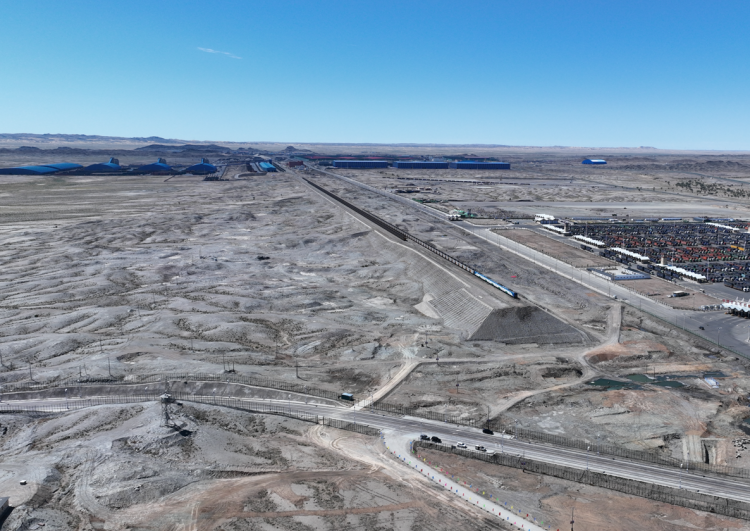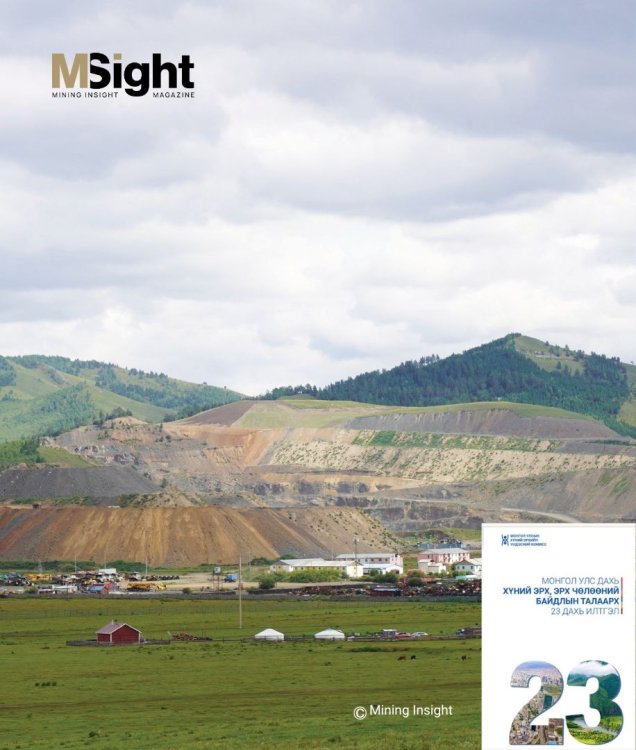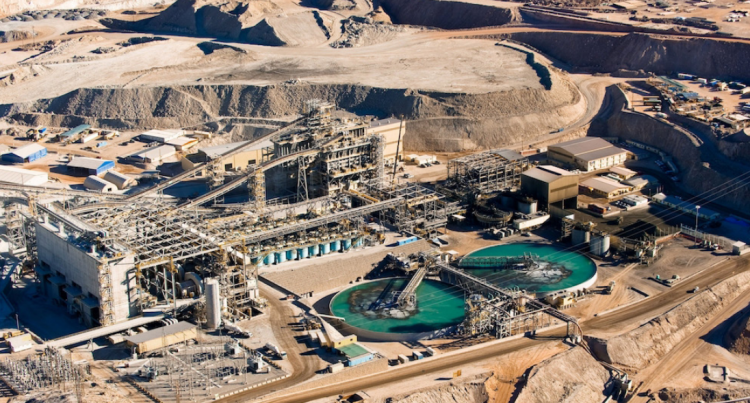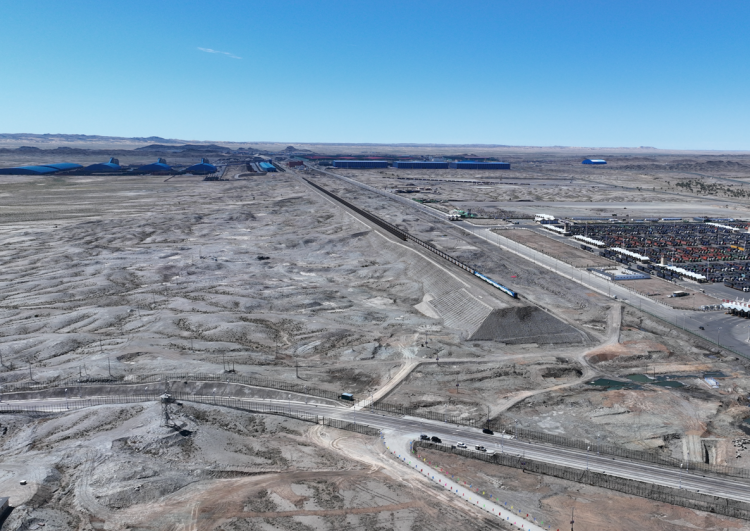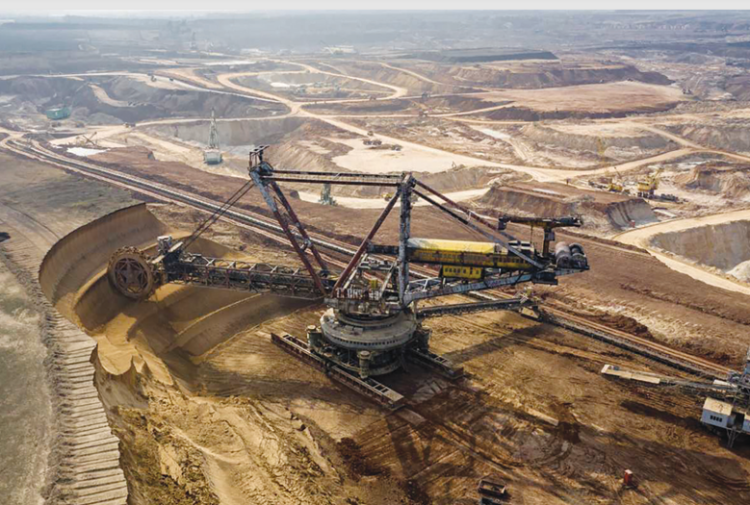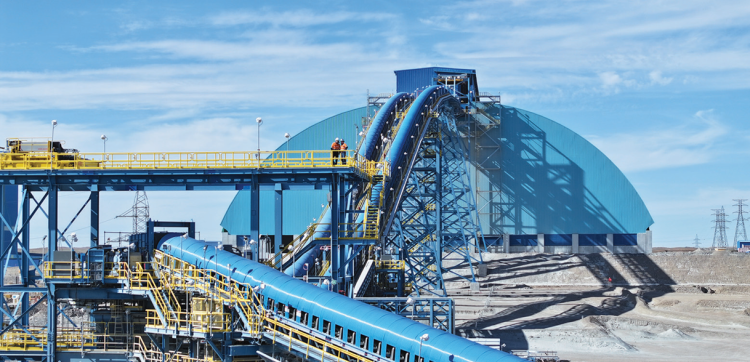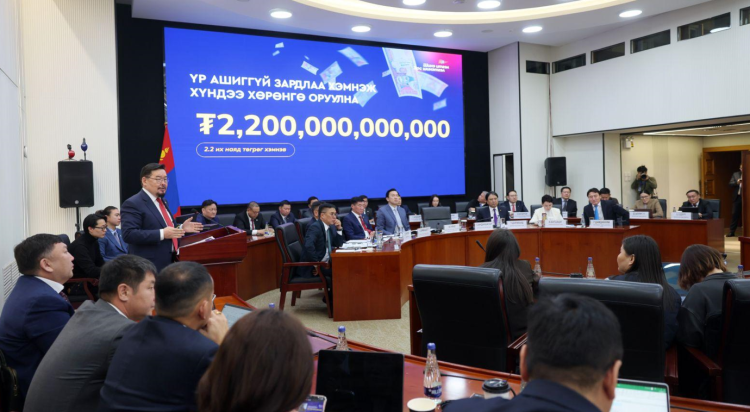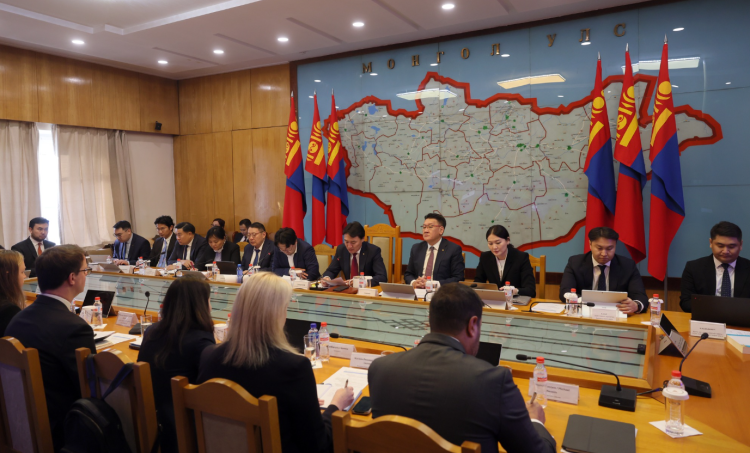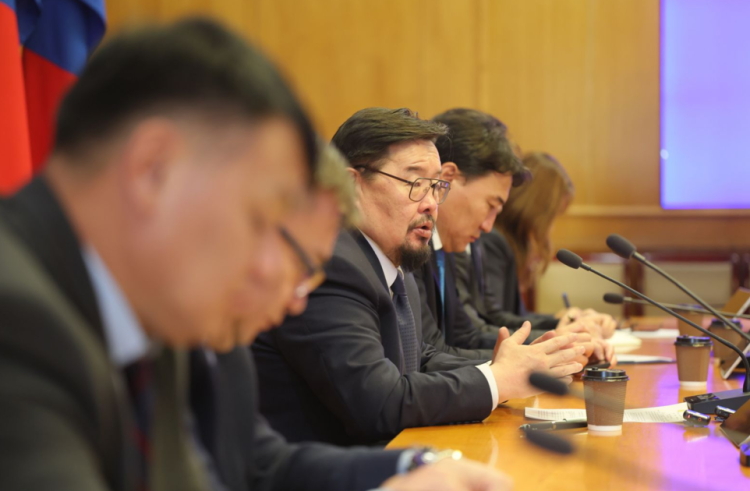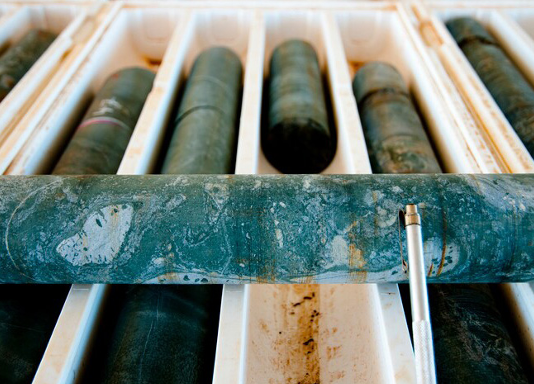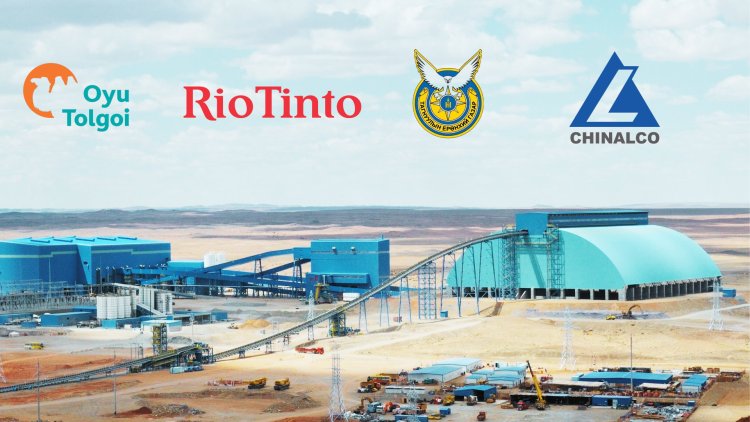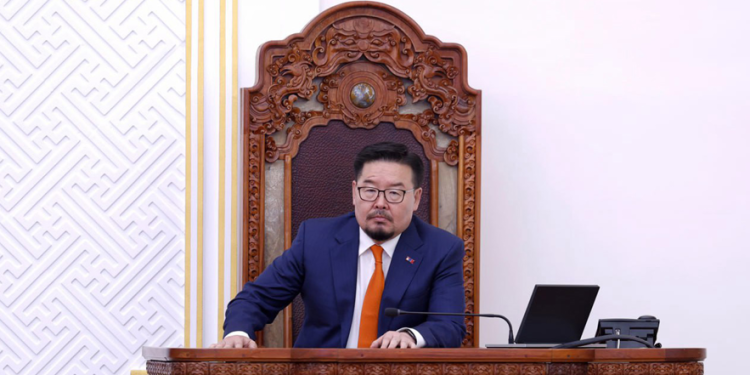od@mininginsight.mn
GASHUUNSUKHAIT GANTSMOD BORDER CHECKPOINT
On windy, stormy spring days, not only railways but all roads in the Gobi become buried in sand, making travel extremely difficult. Traveling over 600 kilometers of unpaved road from Dornogobi to Umnugobi is no easy feat. Passing through the junction of the Zuunbayan–Tavantolgoi and Zuunbayan–Khangi railway lines and speeding along dirt roads, we arrived at Khanbogd soum by midnight. At the break of dawn the next day, we set out for the Gashuunsukhait–Gantsmod border checkpoint to report on the inauguration ceremony of the railway construction that will connect the two countries at the border. During the difficult period of the pandemic, our country managed to build three railway lines using only domestic resources and funding, connecting the core mining regions of two Gobi provinces. Currently, mining products are transported via these infrastructures and unloaded near the border checkpoint, then reloaded into containers and exported to China by road. In other words, the new railways in the Gobi region have yet to become fully efficient infrastructure. However, once connected to the neighboring country's railway network at the border checkpoint, the railways will be fully utilized and become a new gateway to expand mineral exports. Although a special license for the Gashuunsukhait–Tavantolgoi Gantsmod railway was first issued in 2008, debates over the rail gauge delayed the project for over a decade, and the railway still remains incomplete. While a 233-kilometer section from the Tavantolgoi mine was built three years ago by the private company “Bodi International,” a bridge structure for the railway is now being constructed from the border side-about 30 kilometers in-by a Chinese state-owned company. This is the result of an intergovernmental agreement between Mongolia and China to connect the railways at the border checkpoint. On May 14, 2025, a site was prepared at the point zero of the Gashuunsukhait–Gantsmod railway, located at the Mongolia China border, for the official inauguration ceremony. The national flags of both countries were raised, a stage and pavilions were set up, and the machinery and equipment involved in the construction were lined up. On the Gantsmod side, a narrow gauge train was stationed on elevated ground to highlight the railway, immediately catching the eye of visitors. This Togoobulag Gantsmod railway line, which lies just 300 meters from the Mongolian border, was put into operation by China in 2014 under a bilateral agreement. Now, the two countries are about to connect their narrow- and broad-gauge railways at this very location.
ERDENES TAVANTOLGOI TO INVEST MNT 200 BILLION IN THE RAILWAY PROJECT
The ceremony commenced with the signing of agreements. Within the framework of the intergovernmental agreement under the “Three in One” comprehensive cooperation principle, the parties signed and ratified four agreements covering each main area of operation. The agreement to construct the cross-border railway was signed by B. Artur, Chairman of the Board of Mongolia’s Tavantolgoi Railway, and Wang Shanzhong, Chairman of the Board of China Energy Gantsmod Railway Investment LLC. The more than 20-kilometer section from the Gashuunsukhait checkpoint to the Tsagaan Khad settlement area passes through the Inner Mongolia Autonomous Region and is located in a low-lying riverbed. In contrast, the Gantsmod checkpoint in Urad Middle Banner, Bayannur City, Inner Mongolia, is situated on relatively elevated terrain. Therefore, a bridge structure ranging from 8 to 31 meters in height will be constructed to span the depression between the two borders and over the Tsagaan Khad highway. It has been planned that the railway will connect to the Chinese line on the eastern side of the Gashuunsukhait–Gantsmod checkpoint, near Mongolia’s border marker No. 703. China has proposed six times to connect the railway near border marker No. 703, while Mongolia has proposed four times to connect near markers No. 699–700. This lack of consensus delayed the process over time. During the continuation of the earthworks for the Tavantolgoi–Gashuunsukhait railway, it was planned to connect from the western side of the Gashuunsukhait–Gantsmod checkpoint. However, since this route did not align with the Chinese railway, it necessitated the construction of an elevated bridge structure. Now, the Chinese section of the Gashuunsukhait–Gantsmod railway project will be financed by the “China Energy” group. Meanwhile, the investment of MNT 902 billion for the section located within Mongolian territory has been assigned to “Erdenes Tavantolgoi” by Parliamentary Resolution No. 68 of 2023. This year, Erdenes Tavantolgoi’s Board of Directors has approved an allocation of MNT 200 billion for the project.
COAL TO BE SOLD AT USD 59 PER TONNE
A long-term Coal Sales and Purchase Agreement was signed by Kh. Munkhjargal, Acting CEO of Erdenes Tavantolgoi JSC, and Yang Zekun, General Director of China Energy Coking Coal (Tianjin) LLC. Under this agreement, a total of 27 million tonnes of coal will be supplied from the Tavantolgoi coal deposit group between 2025 and 2029, and 20 million tonnes annually starting from 2030. In total, 220 million tonnes of coal will be supplied over the contract period. The contract specifies a selling price of USD 59 per tonne. This price is consistent with the long-term contract rates of Chinese state-owned companies purchasing coal from Mongolia. Kh. Munkhjargal, Acting CEO of Erdenes Tavantolgoi, explained that when transportation costs are added to the contract price, the final cost approaches the market price. For 2025, Mongolia has projected in its state budget an average price of USD 105 per tonne for a total of 85 million tonnes of coal. As of May, the price of coal traded on the Mongolian Stock Exchange stands at USD 65 per tonne.
THIS YEAR, FEASIBLITY STUDIES OF DEPOSITS TO BE APPROVED BY MINERAL RESOURCES COUNCIL
Kh. Munkhjargal, Acting CEO of Erdenes Tavantolgoi JSC, and Wu Chuan, Chairman of the Board of Directors of China Energy International Development, signed a General Cooperation Agreement to increase production capacity by mining coal from the Onchkharaat and Bortolgoi deposits of the Tavantolgoi coal deposit group over a 16-year period. Erdenes Tavantolgoi plans to announce a general exploration tender for these deposits in 2025, and the feasibility studies will be approved by the Mineral Resources Council. According to the agreement, the expansion of mining capacity will begin in 2030. Under the agreement, a subsidiary of "China Energy" group will carry out mining operations for a period of 16 years.
20 MILLION TONNES TO BE TRANSPORTED IN CONTAINERS, 10 MILLION TONNES AS BULK VIA RAILWAY
O. Batchuluun, CEO of Mongolian Railway SOE, and Yang Zekun, General Director of China Energy Coking Coal (Tianjin) LLC, signed a long term coal transportation agreement. By ensuring stable transport operations over 16 years, “Mongolian Railway” SOE is expected to generate USD 2.5 billion in present value. The transport tariff will be indexed annually. According to O. Batchuluun, if coal prices rise, transport tariffs will also increase accordingly. Based on the feasibility study, it has been agreed with the Chinese side that out of the total 30 million tonnes of annual railway capacity, 20 million tonnes will be transported in containers and 10 million tonnes as bulk, all to be delivered to the Gantsmod border port. Specifically, coal laden trains will depart directly from the Tavantolgoi mine station and unload at the Gantsmod port, while other loads will be transshipped at a special terminal at Gantsmod for further transportation deeper into China.
1,500 WORKERS FROM A CHINESE COMPANY TO BUILD THE RAILWAY INFRASTRUCTURE
The railway survey and design work was carried out jointly by Tavantolgoi Railway LLC and China Railway Design Corporation (CRDC) between 2023 and 2024. The project will implement seven main construction packages: superstructure and substructure of the railway, bridge structures, energy infrastructure, buildings and facilities, signaling and communication systems, road infrastructure, and a customs and border inspection complex. The construction phase begins with installation works starting on the project launch date. In the general contractor selection process announced last April, two Chinese companies submitted proposals, and the winner was the China Railway Construction Bridge Engineering Bureau (CRCBEB). This company is a subsidiary of China Railway Construction Corporation (CRCC), ranked 43rd among the global TOP 500 companies, and holds China’s “Special Grade” license for general construction contracting. CRCBEB has an annual revenue of USD 7 billion and over 2,100 employees. It has been presented to the Mongolian side that around 1,500 employees will be mobilized annually to carry out the construction of the Gashuunsukhait–Gantsmod border railway. To expedite the construction work, the Government of Mongolia has issued a resolution to establish a special zone along the border strip.
TALKS BEGIN ON SHIVEEKHUREN-CEKE BORDER RAILWAY
In the afternoon, members of the Mongolian Government visited China’s Gantsmod border crossing and held discussions with Chinese officials. During the meeting, the two sides agreed to launch the next cross border railway project at the Shiveekhuren–Ceke border port. They also discussed advancing and implementing in parallel the railway connection at the Khangi Mandal port, which is already ready to link the two countries, and considered including the Bichigt–Zuunkhataavch port in long-term planning. According to the bilateral agreement signed between the Governments of Mongolia and the People’s Republic of China on July 5, 2004, regarding border ports and their regimes, the operational type and status of each port is mutually determined. In line with this agreement, it was decided that the Gashuunsukhait–Gantsmod, Shiveekhuren–Ceke, and Bichigt Zuunkhataavch ports would be prioritized for connection by rail. With the launch of construction for the Gashuunsukhait–Gantsmod railway, the foundation has now been laid to implement railway connections to the other ports in subsequent phases. The two parties formalized the commitment to build border railways and establish the necessary conditions for cross-border connectivity. The effectiveness of this agreement will be evident over the next 22 months. The Gashuunsukhait Gantsmod railway is expected to be fully operational by the end of 2027. If the construction is successfully completed, it will become the second railway link between Mongolia and China following the Zamyn-Uud–Erenhot railway line established under the 1955 agreement.
Mining Insight Magazine, May 2025, №05 (042)



